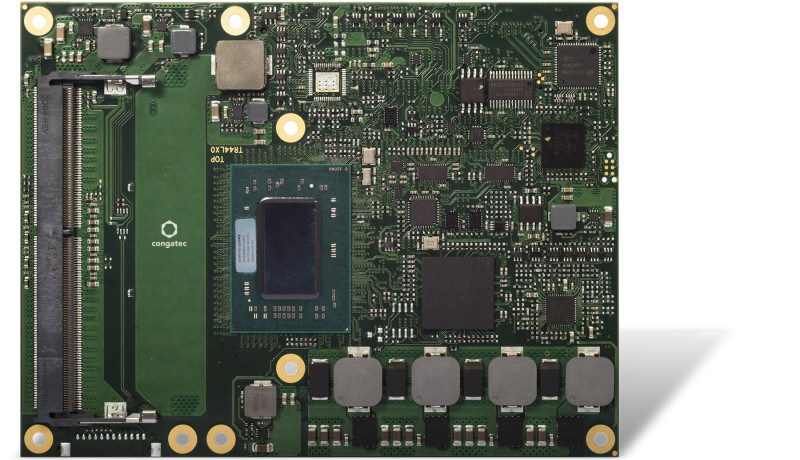conga-TR4: More performance and less dollars per watt
July 16, 2020
on
on

congatec – a leading vendor of embedded computing technology – extends its conga-TR4 series of COM Express modules with processors from the new AMD Ryzen Embedded R1000 series. Based on the acclaimed Zen microarchitecture, this new generation of energy-efficient processors delivers the best low-power computing performance in its class and is optimized for price sensitive markets. Its function set has been slimmed down compared to the AMD Ryzen V1000 processors, yet still offers a range of highly attractive features, including 2 multi-threaded cores, support for three 4k displays with AMD Radeon Vega GPU featuring three compute units. With a TDP that is scalable from 24 to 12 watts and CPU speeds of up to 3.5 GHz, there is massive processing power for individual threads. Featuring an even more impressive graphics performance, the modules are predestined for applications in which OEMs want to emphasize their product quality with ultra immersive graphics.
“With 16% better CPU performance(1) and 33% better GPU performance(2) than its direct competitor, the high-performance R1606G SoC offers decisive competitive advantages. The AMD Ryzen Embedded R1505G offering only slightly lower performance is even more outstanding: It achieves 51% better performance in the CineBench R15(1), and the GPU achieves 91% better performance in 3DMark11(2) compared to the direct competition,” explains Andreas Bergbauer, Product Line Manager COM Express at congatec.
Target markets for the new COM Express Computer-on-Modules based on the AMD Ryzen Embedded R1000 series include graphic-rich multi-display systems for gaming and digital signage, medical imaging and industrial automation. Another application area is headless systems, where the GPU is used for massively parallel data processing. Examples can be found in communication infrastructures, where the modules are used for security applications or for uCPE, SD-WAN, routers, switches and UTM (Unified Threat Management). With a modular system design based on standardized Computer-on-Modules, users benefit from lower development costs and faster time-to-market thanks to an application-ready computing core. Further advantages are the flexible performance scalability even across processor sockets and generations, and high long-term availability.
“With 16% better CPU performance(1) and 33% better GPU performance(2) than its direct competitor, the high-performance R1606G SoC offers decisive competitive advantages. The AMD Ryzen Embedded R1505G offering only slightly lower performance is even more outstanding: It achieves 51% better performance in the CineBench R15(1), and the GPU achieves 91% better performance in 3DMark11(2) compared to the direct competition,” explains Andreas Bergbauer, Product Line Manager COM Express at congatec.
Target markets for the new COM Express Computer-on-Modules based on the AMD Ryzen Embedded R1000 series include graphic-rich multi-display systems for gaming and digital signage, medical imaging and industrial automation. Another application area is headless systems, where the GPU is used for massively parallel data processing. Examples can be found in communication infrastructures, where the modules are used for security applications or for uCPE, SD-WAN, routers, switches and UTM (Unified Threat Management). With a modular system design based on standardized Computer-on-Modules, users benefit from lower development costs and faster time-to-market thanks to an application-ready computing core. Further advantages are the flexible performance scalability even across processor sockets and generations, and high long-term availability.
Read full article
Hide full article



Discussion (0 comments)